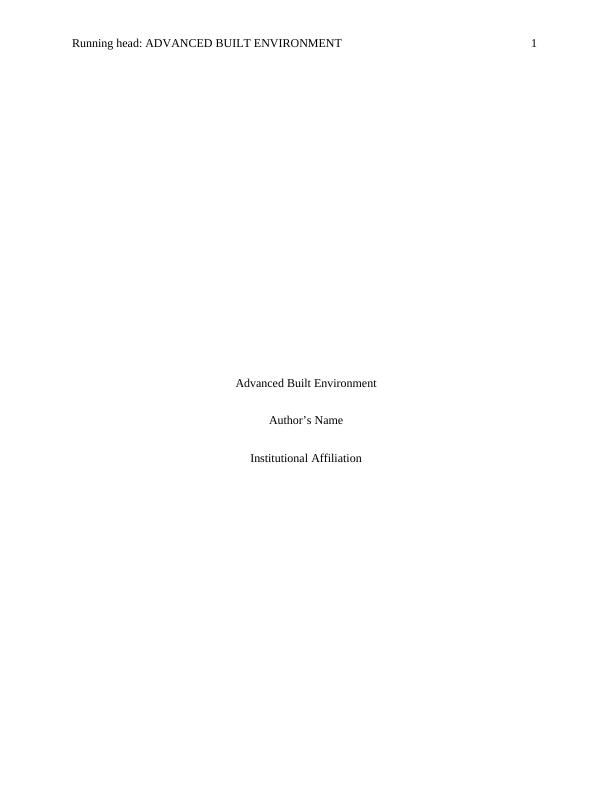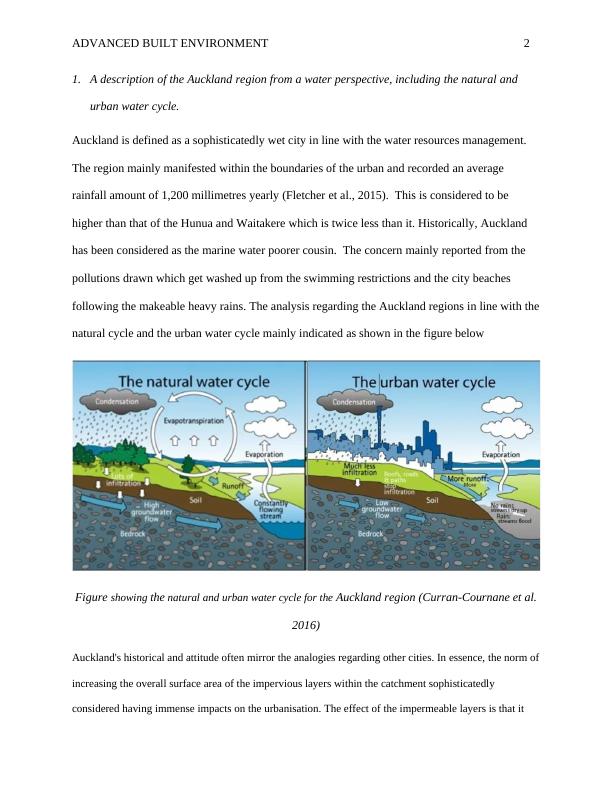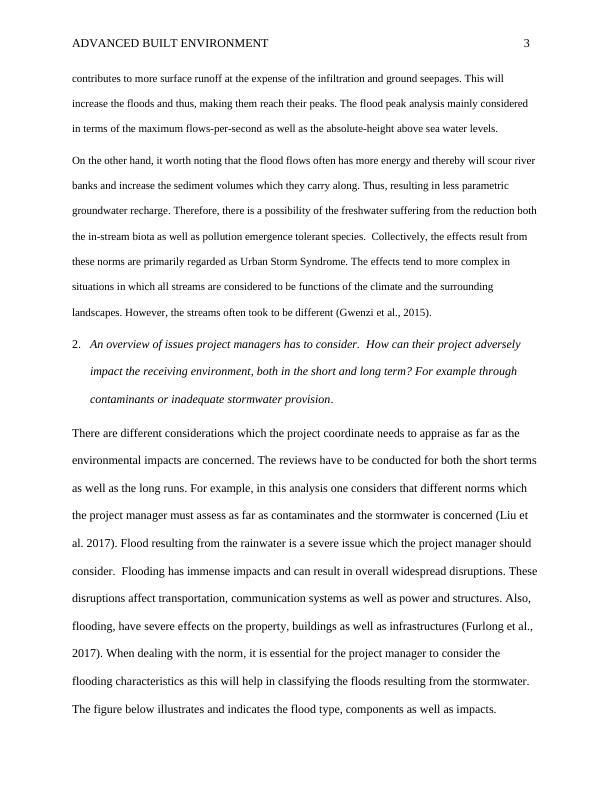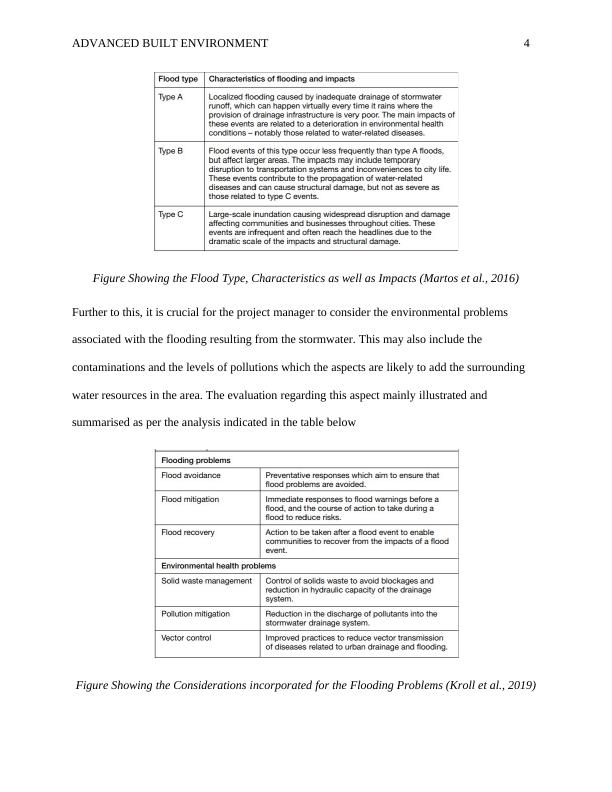Managing Water for Environmental Sustainability
Added on 2023-01-20
15 Pages3406 Words36 Views
Running head: ADVANCED BUILT ENVIRONMENT 1
Advanced Built Environment
Author’s Name
Institutional Affiliation
Advanced Built Environment
Author’s Name
Institutional Affiliation

ADVANCED BUILT ENVIRONMENT 2
1. A description of the Auckland region from a water perspective, including the natural and
urban water cycle.
Auckland is defined as a sophisticatedly wet city in line with the water resources management.
The region mainly manifested within the boundaries of the urban and recorded an average
rainfall amount of 1,200 millimetres yearly (Fletcher et al., 2015). This is considered to be
higher than that of the Hunua and Waitakere which is twice less than it. Historically, Auckland
has been considered as the marine water poorer cousin. The concern mainly reported from the
pollutions drawn which get washed up from the swimming restrictions and the city beaches
following the makeable heavy rains. The analysis regarding the Auckland regions in line with the
natural cycle and the urban water cycle mainly indicated as shown in the figure below
Figure showing the natural and urban water cycle for the Auckland region (Curran-Cournane et al.
2016)
Auckland's historical and attitude often mirror the analogies regarding other cities. In essence, the norm of
increasing the overall surface area of the impervious layers within the catchment sophisticatedly
considered having immense impacts on the urbanisation. The effect of the impermeable layers is that it
1. A description of the Auckland region from a water perspective, including the natural and
urban water cycle.
Auckland is defined as a sophisticatedly wet city in line with the water resources management.
The region mainly manifested within the boundaries of the urban and recorded an average
rainfall amount of 1,200 millimetres yearly (Fletcher et al., 2015). This is considered to be
higher than that of the Hunua and Waitakere which is twice less than it. Historically, Auckland
has been considered as the marine water poorer cousin. The concern mainly reported from the
pollutions drawn which get washed up from the swimming restrictions and the city beaches
following the makeable heavy rains. The analysis regarding the Auckland regions in line with the
natural cycle and the urban water cycle mainly indicated as shown in the figure below
Figure showing the natural and urban water cycle for the Auckland region (Curran-Cournane et al.
2016)
Auckland's historical and attitude often mirror the analogies regarding other cities. In essence, the norm of
increasing the overall surface area of the impervious layers within the catchment sophisticatedly
considered having immense impacts on the urbanisation. The effect of the impermeable layers is that it

ADVANCED BUILT ENVIRONMENT 3
contributes to more surface runoff at the expense of the infiltration and ground seepages. This will
increase the floods and thus, making them reach their peaks. The flood peak analysis mainly considered
in terms of the maximum flows-per-second as well as the absolute-height above sea water levels.
On the other hand, it worth noting that the flood flows often has more energy and thereby will scour river
banks and increase the sediment volumes which they carry along. Thus, resulting in less parametric
groundwater recharge. Therefore, there is a possibility of the freshwater suffering from the reduction both
the in-stream biota as well as pollution emergence tolerant species. Collectively, the effects result from
these norms are primarily regarded as Urban Storm Syndrome. The effects tend to more complex in
situations in which all streams are considered to be functions of the climate and the surrounding
landscapes. However, the streams often took to be different (Gwenzi et al., 2015).
2. An overview of issues project managers has to consider. How can their project adversely
impact the receiving environment, both in the short and long term? For example through
contaminants or inadequate stormwater provision.
There are different considerations which the project coordinate needs to appraise as far as the
environmental impacts are concerned. The reviews have to be conducted for both the short terms
as well as the long runs. For example, in this analysis one considers that different norms which
the project manager must assess as far as contaminates and the stormwater is concerned (Liu et
al. 2017). Flood resulting from the rainwater is a severe issue which the project manager should
consider. Flooding has immense impacts and can result in overall widespread disruptions. These
disruptions affect transportation, communication systems as well as power and structures. Also,
flooding, have severe effects on the property, buildings as well as infrastructures (Furlong et al.,
2017). When dealing with the norm, it is essential for the project manager to consider the
flooding characteristics as this will help in classifying the floods resulting from the stormwater.
The figure below illustrates and indicates the flood type, components as well as impacts.
contributes to more surface runoff at the expense of the infiltration and ground seepages. This will
increase the floods and thus, making them reach their peaks. The flood peak analysis mainly considered
in terms of the maximum flows-per-second as well as the absolute-height above sea water levels.
On the other hand, it worth noting that the flood flows often has more energy and thereby will scour river
banks and increase the sediment volumes which they carry along. Thus, resulting in less parametric
groundwater recharge. Therefore, there is a possibility of the freshwater suffering from the reduction both
the in-stream biota as well as pollution emergence tolerant species. Collectively, the effects result from
these norms are primarily regarded as Urban Storm Syndrome. The effects tend to more complex in
situations in which all streams are considered to be functions of the climate and the surrounding
landscapes. However, the streams often took to be different (Gwenzi et al., 2015).
2. An overview of issues project managers has to consider. How can their project adversely
impact the receiving environment, both in the short and long term? For example through
contaminants or inadequate stormwater provision.
There are different considerations which the project coordinate needs to appraise as far as the
environmental impacts are concerned. The reviews have to be conducted for both the short terms
as well as the long runs. For example, in this analysis one considers that different norms which
the project manager must assess as far as contaminates and the stormwater is concerned (Liu et
al. 2017). Flood resulting from the rainwater is a severe issue which the project manager should
consider. Flooding has immense impacts and can result in overall widespread disruptions. These
disruptions affect transportation, communication systems as well as power and structures. Also,
flooding, have severe effects on the property, buildings as well as infrastructures (Furlong et al.,
2017). When dealing with the norm, it is essential for the project manager to consider the
flooding characteristics as this will help in classifying the floods resulting from the stormwater.
The figure below illustrates and indicates the flood type, components as well as impacts.

ADVANCED BUILT ENVIRONMENT 4
Figure Showing the Flood Type, Characteristics as well as Impacts (Martos et al., 2016)
Further to this, it is crucial for the project manager to consider the environmental problems
associated with the flooding resulting from the stormwater. This may also include the
contaminations and the levels of pollutions which the aspects are likely to add the surrounding
water resources in the area. The evaluation regarding this aspect mainly illustrated and
summarised as per the analysis indicated in the table below
Figure Showing the Considerations incorporated for the Flooding Problems (Kroll et al., 2019)
Figure Showing the Flood Type, Characteristics as well as Impacts (Martos et al., 2016)
Further to this, it is crucial for the project manager to consider the environmental problems
associated with the flooding resulting from the stormwater. This may also include the
contaminations and the levels of pollutions which the aspects are likely to add the surrounding
water resources in the area. The evaluation regarding this aspect mainly illustrated and
summarised as per the analysis indicated in the table below
Figure Showing the Considerations incorporated for the Flooding Problems (Kroll et al., 2019)

End of preview
Want to access all the pages? Upload your documents or become a member.
Related Documents
Environmental Risk Assessment for Water in Australialg...
|11
|2456
|256
